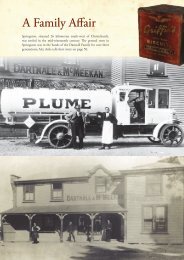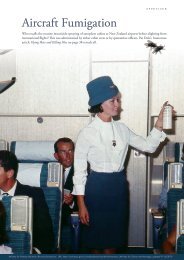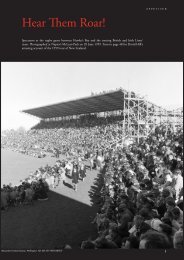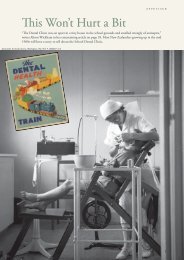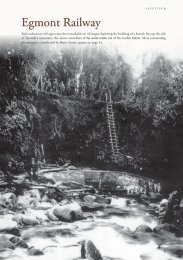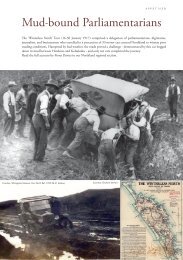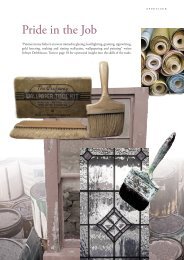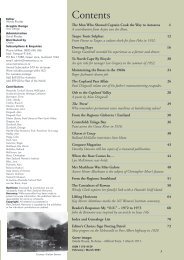You also want an ePaper? Increase the reach of your titles
YUMPU automatically turns print PDFs into web optimized ePapers that Google loves.
APPETISER<br />
Tell the Story<br />
Sam photographed with his son Alf in the late 1990s.<br />
Courtesy: Sam Hunt<br />
An interview with <strong>New</strong> <strong>Zealand</strong> poet Sam Hunt, by<br />
author Rolland McKellar, is published on page 38 and<br />
features photographs from Sam’s personal collection<br />
plus one of his extraordinary works, Salt River Songs.<br />
1
EDITORIAL<br />
Dear Readers,<br />
As I write this note in early January, it is with thankfulness. <strong>New</strong> <strong>Zealand</strong> is<br />
amongst the handful of countries able to enjoy the luxury of a Christmas and<br />
<strong>New</strong> Year break subject to only limited restrictions. With news of vaccines<br />
emerging worldwide, the arrival of a defence against this devastating virus during<br />
mid 2021 is keenly anticipated. Meantime, let commonsense prevail as we keep<br />
each other safe.<br />
I was delighted to find a ‘fount of wisdom’ on navigator Abel Tasman during a<br />
visit to Te Awahou Nieuwe Stroom Museum in Foxton. I have long awaited the<br />
right author to write an article on the 17th century Dutch navigator and the<br />
feature is certainly worthy of the leading placement for 2021.<br />
Personal stories are always a highlight of the magazine. June Peka is welcomed back to our pages with a<br />
heart-warming account of Taupo in the days before tourism expanded the locality, while George Gumbrell’s<br />
memories of droving days in Canterbury reminds us of the hardships of life on the road. And Ian Gregory<br />
experienced his share of road weariness of a different kind during a twenty-five day cycling holiday from<br />
Taihape to Cape Reinga in 1953, quite an adventure for two boys aged fourteen with only seven pounds ten<br />
shillings each in their pockets - “In total we travelled about 2000 kilometres, most of it on gravel roads and all<br />
without getting a puncture”.<br />
Rural women in particular will hold warm memories of the <strong>New</strong> <strong>Zealand</strong> Country Women’s Institute who<br />
have served communities since 1921 … and their work continues. Kay Morris Matthews marks the 100th<br />
anniversary of this esteemed organisation.<br />
The works of Sam Hunt have been an inspiration for almost fifty years. With gratitude we publish one of<br />
Sam’s a recent poems plus a selection of his personal photographs to illustrate Rolland McKellar’s interview.<br />
I recall a fleeting encounter with Sam in the early 1970s when queuing at a buffet table - a larger than life<br />
character in a green velvet jacket and classy boots who ushered me ahead of him in the line with a flourishing<br />
bow. Unforgettable.<br />
I close with the traditional wish of health and happiness.<br />
Wendy Rhodes,<br />
Editor<br />
Subscribe and Save!<br />
For just $79 you receive an annual<br />
subscription to <strong>New</strong> <strong>Zealand</strong> <strong>Memories</strong>.<br />
Six superb issues direct to your letterbox.<br />
A G i f t o f D i s t i n c t i o n<br />
Surprise a friend or relative with a gift subscription. We<br />
will even gift wrap the first issue, include a gift card with<br />
your personal message and post it direct.<br />
Freephone: 0800 696 366 or<br />
Freepost: 91641<br />
PO Box 17288<br />
Green Lane, Auckland 1546<br />
Email: admin@memories.co.nz<br />
Visit our website w w w.memories.co.nz for subscriptions and gift ideas.<br />
Order online securely today and pay via internet banking, cheque or credit card.<br />
2
Editor<br />
Wendy Rhodes<br />
Graphic Design<br />
Icon Design<br />
Administration<br />
David Rhodes<br />
Distributed by<br />
Ovato<br />
Subscriptions & Enquiries<br />
Phone tollfree: 0800 696 366<br />
Mail: Freepost 91641,<br />
PO Box 17288, Green Lane, Auckland 1546<br />
email: admin@memories.co.nz<br />
www.memories.co.nz<br />
Annual Subscription $79 for six issues<br />
(Price includes postage within NZ)<br />
For overseas postage:<br />
Add $69.00 for Australia<br />
Add $99.00 for Rest of the World<br />
Contributors<br />
Alexander Turnbull Library, Wellington<br />
Auckland Libraries Heritage Collection<br />
Barrington, Ernie<br />
Clark, Wendy<br />
Collins, Bruce E.<br />
Dawson, Dorothy<br />
de Bonnaire, John<br />
Dingwall, Alan<br />
Dingwall, Paul<br />
Dixson Library, State Library of <strong>New</strong> South Wales<br />
Gregory, Ian<br />
Gumbrell, Bob<br />
Gumbrell, George<br />
Hawke’s Bay Museums Trust, Ruawharo Tā-ū-rangi<br />
Hedley, Alex<br />
Hogg, Colin<br />
Hunt, Sam<br />
Jackman, Roger<br />
Matthews, Kay Morris<br />
McKellar, Rolland<br />
McKinnon, Lyn<br />
Moor, Christopher<br />
<strong>New</strong> <strong>Zealand</strong> Women’s Institute<br />
Peka, June<br />
Pickmere, Alan<br />
Rakiura Museum<br />
State Library of Victoria<br />
Stewart, Graham<br />
Tairawhiti Museum<br />
Te Awahou Riverside Cultural Park<br />
van der Boon, Arjan<br />
Opinions: Expressed by contributors are not<br />
necessarily those of <strong>New</strong> <strong>Zealand</strong> <strong>Memories</strong>.<br />
Accuracy: While every effort has been made to<br />
present accurate information, the publishers take no<br />
responsibility for errors or omissions.<br />
Copyright: All material as presented in<br />
<strong>New</strong> <strong>Zealand</strong> <strong>Memories</strong> is copyright to the publishers<br />
or the individual contributors as credited.<br />
Contents<br />
The Man Who Showed Captain Cook the Way to Aotearoa 4<br />
A contribution from Arjan van der Boon.<br />
Taupo Tonic Sulphur 12<br />
From Petone to Taupo: a culture shock for June Peka in 1952.<br />
Droving Days 16<br />
George Gumbrell recorded his experiences as a farmer and drover.<br />
To North Cape By Bicycle 20<br />
An epic ride for teenager Ian Gregory in the summer of 1952.<br />
Maintaining the Buses in the 1960s 24<br />
Roger Jackman’s dream job.<br />
The Copland Pass Affair 26<br />
Paul Dingwall relates one of his father’s mountaineering escapades.<br />
Ode to the Copland Valley 28<br />
A poem by Alan Dingwall.<br />
The ‘Perm’ 29<br />
Who remembers permanent wave machines at hairdressing salons?<br />
From the Regions: Gisborne / Eastland 30<br />
Centrefold: Tolaga Bay 36<br />
Punt across the Uawa River in 1916.<br />
Charm it Crazy 38<br />
Rolland McKellar interviews Sam Hunt.<br />
Conquest Magazine 43<br />
Dorothy Dawson still has copies of a treasured publication.<br />
When the Boat Comes In… 44<br />
Lyn McKinnon: war bride.<br />
Mrs Markham Was Miss Galore 48<br />
Actress Honor Blackman is the subject of Christopher Moor’s feature.<br />
From the Regions: Southland 51<br />
The Caretakers of Kawau 58<br />
Wendy Clark explores her family’s link with a Hauraki Gulf island.<br />
Lifting Horizons 64<br />
Kay Morris Matthews marks the NZ Women’s Institute centenary.<br />
Reader’s Response: My “O.E.” – 1972 to 1973 68<br />
John de Bonnaire was inspired by an article in <strong>Issue</strong> 146.<br />
Index and Genealogy List 70<br />
Editor’s Choice: Sign Posting Patrol 72<br />
Slow progress on the Helensville to Port Albert highway in 1929.<br />
Cover image:<br />
Glade House, Te Anau – Milford Track, 1 March 1911.<br />
Courtesy: Graham Stewart<br />
ISSN 1173-4159<br />
February / March 2021<br />
3
EXPLORATION<br />
The Man Who Showed Captain Cook<br />
the Way to Aotearoa<br />
Arjan van der Boon<br />
Co-Chair, Oranjehof Dutch Connection Museum Trust: Marketing Manager, Te Awahou Riverside Cultural Park.<br />
The ships Zeehaen and Heemskerck close to Three Kings Islands sketched by Isaac Gilsemans. View of Cape<br />
Jackson (left) to Stephens Island (right) from the anchorage east of d’Urville.<br />
Alexander Turnbull Library, Wellington, NZ. Ref: PUBL-0105-004<br />
4
EXPLORATION<br />
When Captain James Cook set sail from Tahiti<br />
for our shores in 1769, he took a Polynesian<br />
star navigator on board. The ariori (priest)<br />
Tupaia had extensive knowledge of the<br />
cosmos, the stars, and the more or less exact position of<br />
islands like Samoa, Tonga and Fiji and the lengths of time it<br />
would take to get to each.<br />
But the celebrated explorer and cartographer also took his<br />
lead from another of the world’s great navigators. It is more<br />
than likely that the Endeavour carried a copy of Abel Tasman’s<br />
Journal on board, which was translated in English by one<br />
of his captains – Joseph Banks. We also know that during<br />
his journey, James Cook made use of a scholarly book on<br />
mathematics which included a detailed summary account of<br />
Tasman’s journey – written by Dutchman Van Nierop and<br />
translated into English and published by the Royal Society in<br />
1682. In other words, Captain Cook knew where to go.<br />
Things had been quite different for the seafarer from the<br />
Netherlands – 127 years earlier. Tasman took two small<br />
wooden boats into unknown territory, across perilous southern<br />
seas, to finally end up at the coasts of Te Wai Pounamu and<br />
Te Ika a Maui. Still, many people believe that it is the English<br />
explorer, with multiple statues all across our nation, who was<br />
the first European to ‘discover’ Aotearoa…<br />
International Man of Mystery<br />
So who was this relatively unknown Abel Janszoon Tasman?<br />
What are the mysteries that surround him? We know quite a<br />
lot about his many voyages, insofar as 17th century records<br />
of discovery go. The story of how he arrived at our shores is<br />
well documented through his Journal and some other sources.<br />
He departed from Batavia (nowadays Jakarta) for Mauritius,<br />
where he repaired his run-down ships, so he could head east<br />
with the Trade Winds in his sails. He arrived in Tasmania, had<br />
his encounter with Ngāti Tumatakokiri in Mohua, and then<br />
sailed home touching Tonga, Fiji and Papua <strong>New</strong> Guinea.<br />
The entire arduous journey is exceptionally well illustrated<br />
through maps with highly exact coordinates, and artful<br />
drawings of coastlines and encounters with local inhabitants.<br />
Still, there are some interesting questions to explore like,<br />
what kind of person was he? Do we even know what he<br />
looked like? Did he set foot on land, in what we nowadays<br />
call Golden Bay? And what exactly happened on that fateful<br />
day of 19 December 1642, when Dutch as well as Māori men<br />
died in the brief, violent exchange that took less than half<br />
an hour to unfold. The first-ever encounter between Tangata<br />
Whenua and Europeans…<br />
Above: This ink drawing is a likely portrait of Abel Tasman from<br />
a collection of portraits of early 17th century Dutch admirals,<br />
navigators and officials employed by the Netherlands East<br />
India Company or the companies which amalgamated from it.<br />
Courtesy: Dixson Library, State Library of <strong>New</strong> South Wales<br />
5
EXPLORATION<br />
Humble Beginnings<br />
Both Captain Cook and Commodore Tasman had humble origins, as sons of farmers in a small rural village.<br />
Both also were ambitious, smart and largely self-taught in the skills required to lead ships and men. Each took<br />
advantage of the career opportunities that were offered by navies in turbulent times when many men died at sea,<br />
and international trade was the way to make fortunes. But whilst Cook is celebrated in the English-speaking<br />
Commonwealth, the Dutch have a less favourable opinion about Tasman. A modern authority on his discoveries,<br />
B. J. Slot, puts it this way:<br />
“Tasman was neither a pleasant man nor a gentleman… Tasman never achieved spectacular results and<br />
… His career with the Company [the VOC] ended in frustration” 1<br />
What the historian Slot is probably doing here though, perhaps unwittingly, is comparing Tasman with the<br />
great so-called ‘sea heroes’ (zeehelden) of the Netherlands from the 17th century – fondly remembered on stamps,<br />
bank notes and in history lessons. These are the famous names, who defeated Spanish, Portuguese and English<br />
fleets, made conquests and captured bullion, or ships and hostages, from countries with whom the budding Dutch<br />
republic was at war.<br />
Tasman, for one, would definitely have disagreed with Slot’s assessment. He had transcended his humble origins,<br />
and could happily retire as a wealthy man in the Dutch settlement of Batavia, together with his wife and daughter.<br />
1 B J Slot; Abel Tasman and the discovery of <strong>New</strong> <strong>Zealand</strong> (1992), p.88.<br />
6
EXPLORATION<br />
Above: This is a copy of Frans Visscher’s chart of the discoveries made by Abel Tasman<br />
during his 1642–43 and 1644 voyages. The west coast of <strong>New</strong> <strong>Zealand</strong> is shown at the<br />
bottom. Unlike Tasman’s map, which showed Cook Strait as a bay, Visscher’s shows a gap,<br />
suggesting the presence of a passage.<br />
Alexander Turnbull Library, Wellington, NZ. Ref: B-K 741-96<br />
Left: Most mapmakers in the Netherlands used Tasman’s map of <strong>New</strong> <strong>Zealand</strong> – with Cook<br />
Strait closed off (pictured at left). Others would use Visscher’s version (above) with an<br />
unexplored opening between the North and South Island. This map shows how mapmakers<br />
for over a hundred years were fooled by Tasman’s deceit.<br />
Alexander Turnbull Library, Wellington, NZ. Ref: Mapcoll 830a/1642(1726)/Acc.32129<br />
7
FEATURE<br />
The Copland Pass Affair<br />
Paul Dingwall<br />
My father, Alan Dingwall, was an assistant mountain guide at Mount Cook<br />
during the period 1928 to 1932, spending a number of his university<br />
vacations there. In January 1932, the chief guide, Vic Williams, asked<br />
Alan to join him and assistant-guide Lynn Murray on a trip to the<br />
Copland Valley in Westland to help escort a party across the Copland Pass. This is a<br />
demanding and hazardous route requiring a high degree of mountaineering experience.<br />
The pass is 2,150 metres in altitude, the terrain is rugged and unstable with snow cover<br />
and often icy, and the weather can be wild. 1 A snowstorm forced the guides to stay<br />
overnight in the Hooker hut, after which they made good progress in fresh snow on the<br />
1,000 metre climb to the pass. Their packs were light, containing mainly fresh provisions<br />
for the party, comprising eight loaves of bread and some butter. Having crossed the pass<br />
they negotiated the steep and tortuous descent into the Copland River valley, stopping<br />
briefly at the Douglas Rock hut and a nearby bivouac – a natural shelter under a huge<br />
boulder, its walls blackened by many fires and the ground strewn with some bedding and<br />
an assortment of rusted tins and discarded bottles.<br />
On arrival at Welcome Flat hut they found the party well settled in – a group of 25<br />
members of the Christchurch YMCA tramping club. 2 At four o’clock the next morning,<br />
with Vic, Lynn and Alan leading, a winding cavalcade of eager young men set out on<br />
the ascending trail, aided by torch and flickering candle light. Jumbled masses of storm<br />
clouds ominously began gathering overhead and sweeping down the valley. Three hours<br />
later, on reaching Douglas Rock hut, there was a very brief stop to boil the billy, before<br />
the party continued on upwards in worsening and uncertain weather conditions. Soon<br />
the wind increased, rain gave way to driving snow and the clouds, now at ground level,<br />
reduced visibility to almost nothing. Exposed hands and faces turned blue, teeth began<br />
chattering and feet were stamped to help restore circulation and warmth. Sensing an<br />
impending tragedy, the guides reluctantly signalled a retreat to Douglas Rock hut.<br />
The party was soon crowded around a blazing log fire, lines strung above the fireplace<br />
were hung with an assortment of socks, and the hearth festooned with a confusion of<br />
saturated muddy boots and cold feet. With the rain continuing in torrents and the<br />
impassable, unbridged flooded streams blocking a further retreat down valley, the party<br />
was now trapped within the confines of the hut. And it certainly was confined. Even<br />
with packs stored under bunks and benches and the wet clothing stacked in a lean-to at<br />
the rear of the chimney, it was near impossible for 28 men to move within a space meant<br />
to accommodate fewer than 10, and was accomplished only if two or three moved at<br />
once and were careful where they trod. With the incessant rain drumming on the iron<br />
roof, the wind conveying the roar of the swollen river with large rocks tumbling along<br />
its bed, accompanied by the booming of avalanches spilling over precipices high above,<br />
there arose the prospect of a prolonged stay, which in the event was to extend to three<br />
days and nights. Of immediate concern was the limited food supply. A search of the hut<br />
revealed only a small bag of flour suspended from the rafters, with six cubes of ‘oxo’, and<br />
some tea, salt and sugar in a cupboard, supplementing the meagre supplies of rice and<br />
oatmeal and a can of Symington’s soup from the YMCA group, and what remained of<br />
the bread and butter brought by the guides. For cooking there was only a well-blackened<br />
fry pan and billy to use on the open fire. Long evenings in the dimly lit and smoky hut<br />
were spent with wide-ranging discussions, especially about food, and a song or story<br />
when these flagged. Bedtime was not welcomed. The few over-crowded bunks collapsed<br />
and had to be laced with alpine ropes, while most of the group had to squeeze into the<br />
1 The Department of Conservation warns that a number of climbers have died attempting to cross the Copland Pass.<br />
2 By remarkable coincidence the party included Tom Harker, my future father-in-law.<br />
26
FEATURE<br />
Douglas Rock hut, Westland.<br />
Christchurch YMCA tramping club booklet of 1931-32.<br />
The trip to the glaciers and Mount Cook<br />
limited space available on the floor.<br />
On the third night the rain finally ceased and a few stars appeared. After a hasty breakfast of a slice of bread<br />
from the last remaining loaf, at 3.00 a.m. the young men resumed their quest to reach the summit of the pass. As<br />
dawn broke they gazed in wonder at the magnificent vista of the many towering snow covered summits, with the<br />
three crowning peaks of Aorangi / Mount Cook sharply silhouetted and bathed in the golden glow of sunrise.<br />
The enthralling sight elicited delighted exclamations that broke the silence attending the morning tramp so far.<br />
On reaching the pass, with the guides breaking trail through a deep pack of soft snow, they encountered two<br />
guides sent out by the anxious manager of the Hermitage to locate the overdue party. This additional manpower<br />
proved invaluable for assisting the party members, all attached to guides in a series of ropes, to descend the steep<br />
and hazardous slopes. Alan recalls the difficulty he encountered in negotiating the ‘Devil’s Staircase’, requiring<br />
another guide to belay him (securing a rope around an ice axe) as he lowered his group down on a short rope.<br />
Having safely accomplished the descent, the party then reached the Hooker hut where the very hungry young<br />
men were quickly fortified by a hearty meal of tinned beef and fruit, washed down with lots of billy tea.<br />
Arrival at the Hermitage in mid-afternoon brought the ‘Copland Pass Affair’ to a close. The group had set a<br />
new record as the largest party ever to make a traverse of the Copland Pass. Chief guide Vic Williams declared<br />
that in his 10 years of guiding it was one of the most perfect alpine crossings he had made. The YMCA account,<br />
published as an illustrated booklet, called the Copland Pass traverse the gem of their entire trip, with memories<br />
of “a day that will never fade from our minds”. Alan reflected that the adventure was a lesson in fortitude and<br />
human relationships. Together with the awe inspiring scenery, it made a lasting emotional impression on him<br />
that he expressed in a romantic poem Ode to the Copland Valley. n<br />
The poem is printed on the following page.<br />
27
REGIONS<br />
36
Alexander Turnbull Library, Wellington, NZ1/1-022067-G<br />
GISBORNE / EASTLAND<br />
Tolaga Bay<br />
Transporting sheep on a punt over the Uawa River. Photographed by Frederick Hargreaves in about 1916. The<br />
punt was built by Mr E.B. Boland following damage to the Uawa River bridge (built 1905) during the 1916 floods.<br />
37
FEATURE<br />
Lifting Horizons<br />
The <strong>New</strong> <strong>Zealand</strong> Women’s Institute celebrates 100 years<br />
Kay Morris Matthews<br />
My mother was a member of the<br />
Women’s Institute for 50 years and<br />
really enjoyed the friendship and<br />
camaraderie of the women in the<br />
organisation.<br />
She sang in the choral section and acted in the<br />
dramatic productions. She entered floral art and<br />
handicraft competitions and had a drawer full of<br />
certificates as evidence of her successes. Mum also did<br />
her bit serving on the Bay View branch committee and<br />
attended a great many meetings<br />
One particular custom she enjoyed, and often spoke<br />
about, was having an anonymous ‘special friend’<br />
allocated each year. This was someone who would<br />
remember her birthday and bring food if she was ill. It<br />
was always such a pleasant surprise to discover at the<br />
end of each year just who that special friend had been.<br />
Friendship and support have always been<br />
fundamental to the <strong>New</strong> <strong>Zealand</strong> Women’s Institute.<br />
So too, is having fun and providing opportunities to<br />
participate in educational and cultural group activities<br />
and events. Indeed, such has been the appeal of the<br />
Women’s Institute that tens of thousands of women<br />
joined and it became the largest women’s organisation<br />
in <strong>New</strong> <strong>Zealand</strong>.<br />
So where did the idea of a women’s institute<br />
come from? It originated in Hawke’s Bay, in a small<br />
settlement called Rissington, about 17 miles west of<br />
Napier. The first meeting there, and many meetings<br />
after that, were held at Omatua, a local homestead.<br />
Omatua was the home of Amy and Frank Hutchinson<br />
who were sheep farmers. Omatua was also the home<br />
of Anna Elizabeth Jerome Spencer, who lived with<br />
them.<br />
Jerome Spencer and Amy Hutchinson understood<br />
that women who lived in the country, were often<br />
socially isolated. In 1914, they began a World War<br />
One Soldier Relief Scheme as part of the <strong>New</strong> <strong>Zealand</strong><br />
Red Cross, which saw local women gathering regularly<br />
at Omatua, where there was plenty of space, to work<br />
together on knitting, sewing and parcel packing.<br />
Of particular enjoyment for the women were the<br />
sessions that Jerome Spencer planned, like a talk on<br />
invalid cookery, or discussing a topic of mutual interest<br />
as they knitted and sewed. A support network arose<br />
from their conversation and sharing of skills. Women<br />
began to visit one another and help each other out<br />
when, for example, a family member became ill or was<br />
wounded on the battlefield. They also comforted each<br />
other when, in several cases, local men were killed in<br />
action.<br />
By 1916, when Jerome Spencer went to England to<br />
volunteer her services for the war effort, she and Amy<br />
Hutchinson believed that the gatherings of the women<br />
would be greatly missed once the war ended. Writing<br />
to Amy at Rissington, Jerome Spencer reported having<br />
visited a display of handcrafts by branches of the<br />
English Women’s Institute in London. She attended a<br />
few meetings and spoke with members of the executive<br />
body in a bid to find out as much as she could about<br />
the Institute.<br />
Once back in <strong>New</strong> <strong>Zealand</strong>, Amy Hutchinson,<br />
who was credited as being the spiritual founder of the<br />
Women’s Institute, sent out invitations to women of<br />
the Rissington district inviting them to Omatua for<br />
an afternoon tea meeting on 21 February 1921. There,<br />
Jerome Spencer spoke of what she seen of the English<br />
Women’s Institutes and wondered if there would be<br />
sufficient interest in starting a branch at Rissington.<br />
The levels of support were such that on 27 February<br />
1921, the first meeting was held.<br />
The camaraderie of women was the core of the<br />
Women’s Institute, a foil to the everyday work of the<br />
farming woman, filled with child rearing, cooking,<br />
housework and farm chores. Jerome Spencer spoke of,<br />
and wrote about, the value of “true neighbourliness<br />
and cultivation of kindly feelings”.<br />
She added her own ideas and understandings of <strong>New</strong><br />
<strong>Zealand</strong> rural women’s lives. Her thoughtful attention<br />
to what would most appeal to women, in order to<br />
have them sign up as Institute members, was key to<br />
the huge success of the <strong>New</strong> <strong>Zealand</strong> movement. She<br />
understood that for many farm women, the attraction<br />
of the meetings was the company of other women.<br />
For some it was the only time each month when they<br />
interacted with others outside their immediate family<br />
or farm. Having time-out and having fun was part of<br />
her plan.<br />
As she said: “At these meetings all the women of<br />
a district, rich and poor, learned and unlearned, of<br />
64
FEATURE<br />
The first Women’s Institute members at Rissington, 27 February 1921. Amy Hutchinson, is seated at left in the<br />
middle row. Next to her is Jerome Spencer. Collection of Hawke’s Bay Museums Trust, Ruawharo Tā-ū-rangi, [17266]<br />
65
EDITOR’S CHOICE<br />
Sign Posting Patrol<br />
Slow progress for the first Auto Automobile Association Sign Posting Patrol truck along the main highway<br />
between Helensville and Port Albert in 1929. Photographed during a road sign posting exercise in the Province<br />
of Auckland. The number plate is 1-800. Courtesy: Graham Stewart<br />
72






